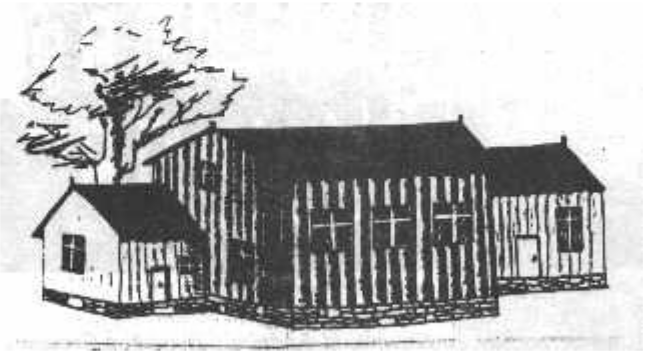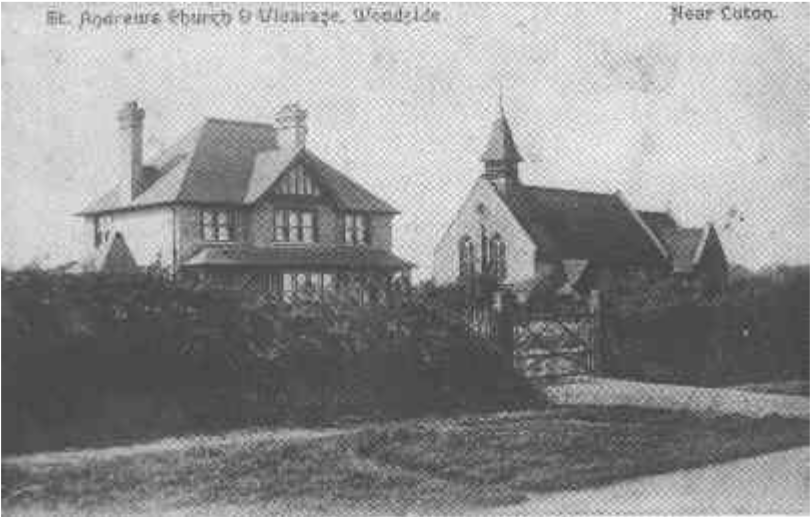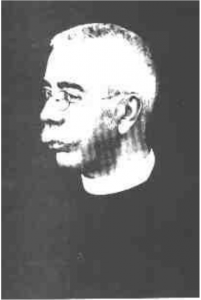The History of Saint Andrew’s Church
By the 1870s, Slip End was an expanding village in the parish of Caddington, and Pepperstock in the parish of Flamstead. More significantly, it was on the doorstep of Stockwood Estate, the home of the Crawley family, an important Bedfordshire landowner. Slip End had come about because of the establishment of a brickmaking industry and the clearing of land which need agricultural labour. St Andrew’s came about because of the interest of the Crawley family.
Origins
We can but guess what other factors lie behind the planting of a church
in Slip End. In an age of denominational competition, was the church at
Caddington jealous or concerned at the popularity of the Baptist
churches at Woodside and Pepperstock and the Medhodist chapel at Slip
End? Their attendances were very high. How deliberate was the decision
to build a mission church, virtually opposite the Methodist church?

The Iron Room
Our earliest factual record is that a “Mission Chapel” was built at
Slip End in 1878. At this stage, you may be confused as to why we are
celebrating St Andrew’s Centenary in 1989. The church building was
erected in 1889, which story we tell later, but before this there was a
chapel on a different site. Known later as the `Iron Room’ this chapel
was St Andrew’s first home; a corrugated iron building with tongue and
groove boarding inside. It looked for all intents and purposes like a
church. There was a porch with a bell (now at Wardown Museum),
wooden frames for seating and a platform at the front with a vestry
beyond. First used as a church, after 1889 it was used solely as a
Sunday school and between the wars as a Youth Club. After the war it
fell into disuse, presumably through need of repair and became a
builders yard. Finally it was demolished and the site is now the car
park to the Frog and Rhubarb.
In the early years the mission chapel was to be serviced by curates
from Caddington and laymen. In a letter from the Ecclesiastical
Commissioners in June 1879 they refer to an application by the Vicar of
Caddington for a grant of £60 to help pay for an assistant curate. When
did services begin? We cannot be sure. The register does not begin until
1882, and the first service recorded there on October 8th seems a
special one, and therefore presumably a `first’. Untypically there were
three services which were conducted by the Rev’s Storey and Harrison,
whereas the services there afterwere two each Sunday conducted by others
on a more regular basis. The collections were three times greater tan
what was to become normal and the number of communicants higher. So, if
services began in 1882, what was going on in the years in between? It is
to the Crawley family that we turn to provide the clues.
The Crawley Connection
John Sambrooke Crawley gave the land, and presumably built the mission
chapel. The Crawley family were well established, tracing their family
history back to the 14th century. J. S. Crawley had two well documented
interests, farming and church building. He restored the chancel of St
Mary’s parish church, built and endowed Holy Trinity East Hyde, and
contributed generously to the building and endowment of St Thomas’
Stopsley, Christ Church Luton (since demolished), St Matthew’s, St
Paul’s Luton (built a year after St Andrew’s), St Andrew’s Blenheim
Crescent, St Saviour’s and Holy Trinity Biscot. In addition he built
four church schools and a hospital. It was then in character that he
should pioneer a church at Slip End. Of his nine children, three girls
never married and these three Crawley ladies took a keen interest in
establishing a Sunday school at Slip End. It is likely, then, that the
original emphasis at the mission chapel was the Sunday school which
Ethel, Helen and Florence organised. Many of the estate cottages were at
that time at the Slip End side of Stockwood Estate, and so the children
of the servants and estate workers would have been core of the Sunday
school. If the services did not begin until 1882, the childrens’ work
began long before that. In the first ten years there were over two
hundred baptisms, not only of those who lived on the estate but also
many local children . The first baptism is recorded on March 6th 1879.
Contrasting with the many baptisms are just four confirmations and low
adult attendance at services. A Font was given by the “children of Slip
End” in 1888. It is ornate and was not cheap, being made of stone. These
facts taken together seem to suggest not just that the Sunday school
was where the work of St Andrew’s began but wherein lay its strength.
The foundations were being laid more by the interest of the Crawley
family in their Sunday school work than in the outreach of Caddington
based Clergy.

The Building of St Andrew’s in 1889
Very
little is known about this, probably because it was the particular
interest of the Crawley family. The `Crawley Papers’ kept at the County
Records Office do not furnish us with any information. It is no suprise
then that an error of dating crept in at an early stage. Kelly’s
Directories of the 1890s record that the church was built in 1890. We do
not know whether they were the first to make the mistake, but
thereafter the majority of histories give 1890 as the date of the
church. They are wrong.
We can’t be sure when the work began, but the church was completed apart from interior lighting by the time of its dedication on 24th December 1889. The land was of course given by J. S. Crawley and with his daughters they supervised the building themselves, using their own men from the Stockwood Estate as the builders, and only contracting out the more specialised aspects of the work. A local firm, J. R. Brown & Sons were hired as the architects. We can guess that because Mr. Crawley used his own men as labourers the building was spread out over a long time. The dedication on Christmas Eve was more likely due to finding a date when a busy Bishop of Ely and his Archdeacon were free than due to wanting to use the church for Christmas. By the dedication service everything was in place apart from the lighting. The organ was in place, the pulpit and Font had been removed from the mission chapel, the gardens were laid out to trees and shrubs, and the bells were rung.
It is possible that J. S. Crawley had set his heart on building the church long before. St Andrew’s being on the doorstep of his Stockwood Estate, was to become his church, and was built as a chapel-at-ease rather than as a parish church. This gave him licence to build to his own taste and the building tells us much. Unlike many Victorian church buildings, St Andrew’s was built to `Early English’ design, not gothic; modest and simple rather than grand and majestic. The ornate stained glass in the nave and the East End are later additions. The reredos (obscured now by a curtain) was simple, with only one symbol, a cross. Examining motives, we would think that he would be tempted to build a church grand and glorious, to display his wealth and generosity: this temptation he obviously resisted. There was nothing in the church inside or out which attempted to deflect the eye from the preacher. He was happy with this design and presumbly happy too that a relatively uneducated man, a preacher and `low church’ in tradition should be the first incumbent.
In the late spring of 1889 the Vicar of Caddington, the Rev. Thomas Prescott died. He had taken little or no interest in the mission chapel at Slip End and possibly was cool about the erection of a church building. It may be that on his death J. S. Crawley made the decision to build St. Andrew’s and wasted no time in doing it. In the Interregnum the Dean and Chapter of St Pauls who chose as `Patrons’ the Vicars of Caddington, decided to divide the Parish into two. Such things take time but they presumably secured this intention before appointing the next Incumbent to Caddington. It was already known in 1889 that St Andrew’s would become a Parish church. The legalities sorted out, J. S. Crawley conveyed the site and building over to the Ecclesiastical Commissioners in March 1892, the ground was consecrated for burial purposes in April, and the church consecrated on July 1st. This meant that Philip Hyne was promoted from Curate to Incumbent Vicar and was able to conduct marriages and burials. All this was approved `by order in council’ and published in the London Gazette on 23rd August 1892. The chapel-at-ease was now Woodside Parish Church: Caddington was now carved in two. The new church of St. Andrew’s was the chosen place of worship for the Stockwood estate and Crawley family.

Rogues Gallery
St Andrew’s is fortunate to have framed photographs of all the Vicars this hundred years. The first Vicar, Philip Hyne,
was to make his mark on the place. He was to remain in Slip End for
fifty two years, even though the endowment (annual allowance) was modest
by 19th century standards. Why did he not move on? We will probably
never know. In 1879 he trained at St Aidan’s college, having had no
Oxbridge pedigree normal to most Church of England clergy. He was
ordained in 1881 and served first as a curate at St Andrew’s Cathedral,
Aberdeen and in 1883 moved to Kensworth, nearby. When he moved the short
distance to Slip End, it was again as curate, but in 1892 St. Andrew’s
became a parish in its own right and so he received the title `Vicar’.
It was 26th May 1886 when he came to Slip End and on May 30th preached
twice at the mission chapel. He recorded the texts he used in the
register and occasionally the attendance and the collections. There was
Mattins and Sermon at 11, Sunday school at 2.30 and Evensong and Sermon
at 6. The pattern was to vary little over the years. At first Mr Hyne
was to live in Summer Street, opposite the Working Mens Club. From all
accounts he was a good preacher, but he did not get on well with the
chapels and he was thought of as being a class apart. In 1903 a new and
very grand Vicarage was to be built for him which took him a little
further out of the village and can only have underlined the class
difference.In February 1936 he was taken ill during a service and took
few services after that. His handwriting changes quite significantly and
his last appearance was in October 1937. There is no sign of a farewell
or a thank you or a send off. He retired in Luton and died shortly
afterwards.
None of Philip Hyne’s successors were to remain a long time at Woodside Vicarage: there is nothing very significant in that. Clergy with a `benefice’ were not required to move but many of them did. Gordon Edward Quinion came in December 1937 and remained almost four years. He was a graduate of Selwyn college, Cambridge and the intellectual among Slip End’s line of Vicars. He was ordained in 1927; Woodside was his 4th post and he was to hold two more after. A bachelor, he was handicapped with failing eyesight. There are some today who remember him losing his sight completely while preaching in the pulpit and having to be helped down. At the end of the War he flew to Utrecht, Holland for an operation on his sight: we presume it was successful.The war years inevitably disrupted church life. Between the wars the church choir had a boost as men and women from Luton who sang with the choir at Luton Hoo came to Woodside after it was disbanded. Much of that tradition was to be put to one side during the war. The same is true of the clergy. A Mr Bentley, who was Vicar of St. Matthew’s became `Curate’ at Woodside, also had a wife and family but was a sick man.
Bernard Matthew Lambert came in May 1943 and remained a respectable eight years. In his early thirties when he came, he was a graduate of Kings College London and was ordained in 1932. Woodside was his fifth post, the first three having been in London. There was presumably a shortage of clergy at this time and in 1944 he was also curate in charge of Caddington until 1950. During the war, St Bartholomew’s Hospital in Kent had moved residence to Stockwood House where it was known as the Alexandra Hospital for children. Mr Lambert was chaplain there for seven years. After leaving Slip End he was to take up 2 further posts in London.
The next Incumbent was Hugh Warwick, like Quinion a bachelor and when he came his parents moved in with him. He was the youngest of the incumbents and the only other Oxbridge graduate, from St Edmunds Hall. He was ordained in 1946 and was curate for six years in North London before moving to Slip End. He remained five years and suffered from ill health. Towards the end of his time he married a nurse from the Alexandra Hospital. From Woodside he went to hospital chaplaincy with St Bartholomew’s for 2 years and then back to St. Albans where he held two further posts.
Kenneth Ashworth was the next Vicar and was to leave his mark in a number of ways. A graduate of Birmingham University, ordained in 1936, Woodside was his thirteenth post (four of them were concurrent!),but his longest stay, ten years. His wife taught for a while at East Hyde Village School. Kenneth Ashworth is remembered not only for his preaching but also for his regular columns in the Newspapers and his initiation of local activities, most notably the Friendship Club. Like a few of his predecessors he suffered poor health but lived on well into retirement.
The next incumbent is Dennis Cooper. He was ordained when he was 46 and Woodside was his last parish up to retirement. Dennis remained thirteen years, becoming Vicar of East Hyde (they have been joint appointments since) and towards the end of his time moved into the New Vicarage built next door to the old one. Dennis was well known for his participation on the Parish Council and the Luton Rotary Club.
Michael Withey is the third bachelor among the list. A graduate of the open University he was ordained in 1974 and Woodside with East Hyde was his third post, remaining for nearly seven years. Whilst here, Michael Withey was appointed as chaplain in the Territorial Army. He is remembered for his parachute jump near Ipswich which was sponsored in aid of church fabric, and a fierce alsatian dog which kept guard in the Vicarage!
The next incumbent was David Bolster, who was in post longer than any of his predecessors except of course, Philip Hyne. A graduate of Exeter and London Universities, he was ordained in 1984 and came here in May 1987, leaving in July 2001. His wife, Mary, is a nurse and they have three children. Like Dennis Cooper, David Bolster was ordained later in his career, Woodside is his second post.
Joy Daniel was our previous Vicar; and was the first female incumbent to be appointed at St Andrews. She was installed on 4th June 2002 and stayed until 12th September 2010, when she retired from full time Ministry. She trained for the Ministry at Oak Hill Theological College. She served first as a Deaconess, and then Deacon before Female Ministers were allowed to be Ordained Priest. She was Ordained Priest in St Albans Abbey on 23rd April 1994, and served at St. Hugh’s Cockenhoe before coming to St. Andrew’s as Priest in Charge.
Currently we have Cathy Pullinger. Cathy is a graduate of York University where she became a Christian and got married to Iain. In some ways she followed in the footsteps of Joy and also trained at Oak Hill Theological College. She was ordained Deacon in September 1993 and Priest in June 1997. She has served in St Paul’s Luton and then at St. Hugh’s as a SSM, before being licensed as Priest in Charge at St. Andrew’s.
Photographs of all past incumbents hang in the `Rogues Gallery’ in the vestry of St. Andrew’s Church.
